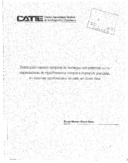| dc.contributor.advisor | HILJE, L | |
| dc.contributor.author | Varón Devia, Edgar H. | |
| dc.date.accessioned | 2014-10-18T03:33:30Z | |
| dc.date.available | 2014-10-18T03:33:30Z | |
| dc.date.issued | 2002 | es_ES |
| dc.identifier | 337042 | es_ES |
| dc.identifier.uri | https://repositorio.catie.ac.cr/handle/11554/4189 | |
| dc.description | Tesis (Mag. Sc) -- CATIE, Turrialba (Costa Rica),2002 | es_ES |
| dc.description | 97 páginas | |
| dc.description | 7 ilus. 14 tab. | |
| dc.description | Referencias 77-86 | |
| dc.description.abstract | En Mesoamérica y el Caribe es común la presencia de árboles de sombra en los sistemas agroforestales de café (Coffea arabica). En años recientes se ha demostrado que estos sistemas pueden albergar altos niveles de biodiversidad de insectos, incluyendo a hormigas, que podrían actuar como depredadoras de plagas claves en dichos sistemas. Por tanto, mediante pruebas de escogencia en el laboratorio y el campo, se determinó el potencial de depredación de las especies más abundantes (Solenopsis geminata, Pheidole radoszkowskii y Crematogaster spp.) sobre varios estadios de la broca del café (Hypothenemus hampei) y el barrenador de las meliáceas (Hypsipyla grandella). Asímismo, para valorar el efecto de la sombra sobre las poblaciones de estas hormigas, se evaluó su abundancia a través de un gradiente de sol-sombra en un cafetal con cuatro parcelas alternas (desde pleno sol hasta sombra total), en Turrialba, Costa Rica. En condiciones de laboratorio, S. geminata, P. radoszkowskii y Crematogaster spp. causaron depredación en al menos un estadio de H. grandella y de H. hampei, a veces con niveles de hasta 100 por ciento. No obstante, esto no ocurrió en el campo, ya que ni las dos primeras especies ni C. torosa depredaron de manera significativa ningún estadio de la broca, aunque S. geminata sí lo hizo sobre huevos de H. grandella. | es_ES |
| dc.description.abstract | In Mesoamerica and the Caribbean it is common to have shading trees within coffee agroforestry systeMON (Coffea arabica). In recent years, it has been demonstrated that these systeMON can contain high levels of insect biodiversity, including ants that could act as predators of key pests attacking them. Because of that, through laboratory and field choosing tests it was possible to determine the predation potential of the most abundant ant species (Solenopsis geminata, Pheidole radoszkowskii and Crematogaster spp.) to several coffee berry borer (Hypothenemus hampei) and mahogany shoot borer (Hypsipyla grandella) developmental stages. Likewise, in order to assess shade effect on ants population, a sun-shade gradient was established to evaluate its abundance in a coffee plantation with four alternate plots (from full sun to complete shade) in Turrialba, Costa Rica. Under laboratory conditions, S. geminata, P. radoszkowskii and Crematogaster spp. caused predation to at least one stage of H. grandella and H. hampei, sometimes up to 100 percent levels. Nevertheless, this did not occur at the field as neither of the two first species nor C. torosa caused a significant predation on any coffee berry borer's stage, although S. geminata did predate H. grandella eggs. | |
| dc.language.iso | es | es_ES |
| dc.publisher | CATIE, Turrialba (Costa Rica) | es_ES |
| dc.relation.ispartof | Magister Scientiae en Agricultura Ecológica | |
| dc.subject | AGROFORESTRY | |
| dc.subject | FRUIT DAMAGING INSECTS | |
| dc.subject | GEOGRAPHICAL DISTRIBUTION | |
| dc.subject | ANIMAL ECOLOGY | |
| dc.subject | LIFE CYCLE | |
| dc.subject | SHADE PLANTS | |
| dc.subject | HOSTS | |
| dc.subject | CREMATOGASTER | |
| dc.subject | POPULATION DYNAMICSCOSTA RICA | |
| dc.subject | COFFEA ARABICA | |
| dc.subject | AGROFORESTERIA | |
| dc.subject | FORMICIDAE | |
| dc.subject | HYPOTHENEMUS HAMPEI | |
| dc.subject | INSECTOS DEPREDADORES DE LOS FRUTOS | |
| dc.subject | HYPSIPYLA GRANDELLA | |
| dc.subject | LEPIDOPTERA | |
| dc.subject | DISTRIBUCION GEOGRAFICA | |
| dc.subject | ECOLOGIA ANIMAL | |
| dc.subject | CICLO VITAL | |
| dc.subject | PLANTAS DE SOMBRA | |
| dc.subject | HUESPEDES | |
| dc.subject | SOLENOPSIS GEMINATA | |
| dc.subject | PHEIDOLE RODOSZKOWSKII | |
| dc.subject | CREMATOGASTER | |
| dc.subject | DINAMICA DE POBLACIONES | |
| dc.title | Distribución espacio-temporal de hormigas con potencial como depredadoras de Hypothenemus hampei e Hypsipyla grandella, en sistemas agroforestales de café, en Costa Rica | es_ES |
| dc.title.alternative | Temporal and spatial distribution of predatory ants and their potential to control the coffee berry borer (Hypothenemus hampei) and the mahogany shoot borer (Hypsipyla grandella) in coffee agroforestry systems in Costa Rica | es_ES |
| dc.type | Tesis de maestría | es_ES |
| dc.identifier.publication | Turrialba (Costa Rica) | es_ES |


